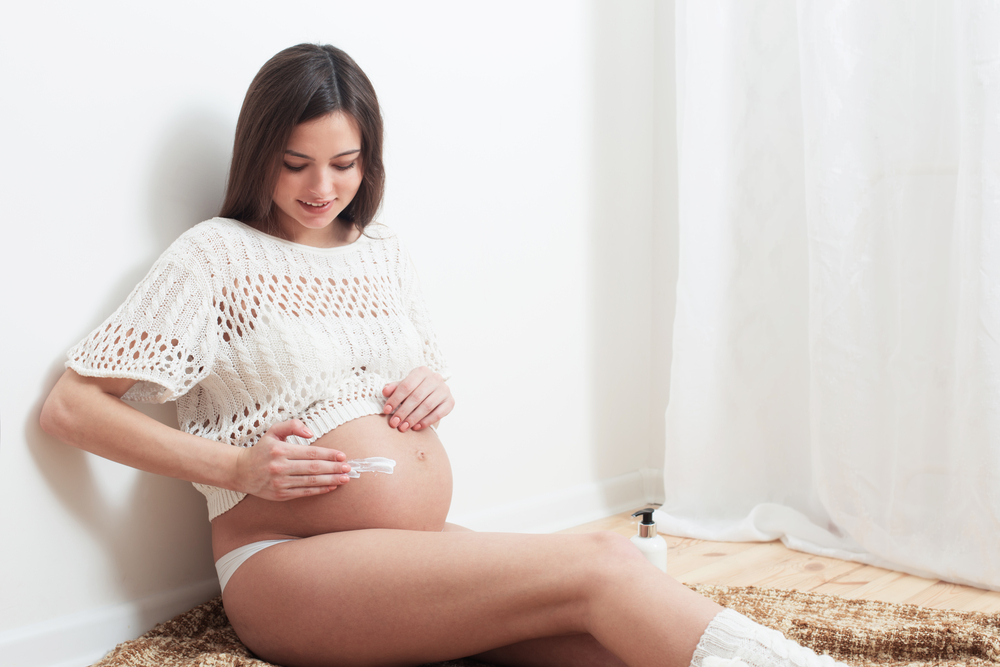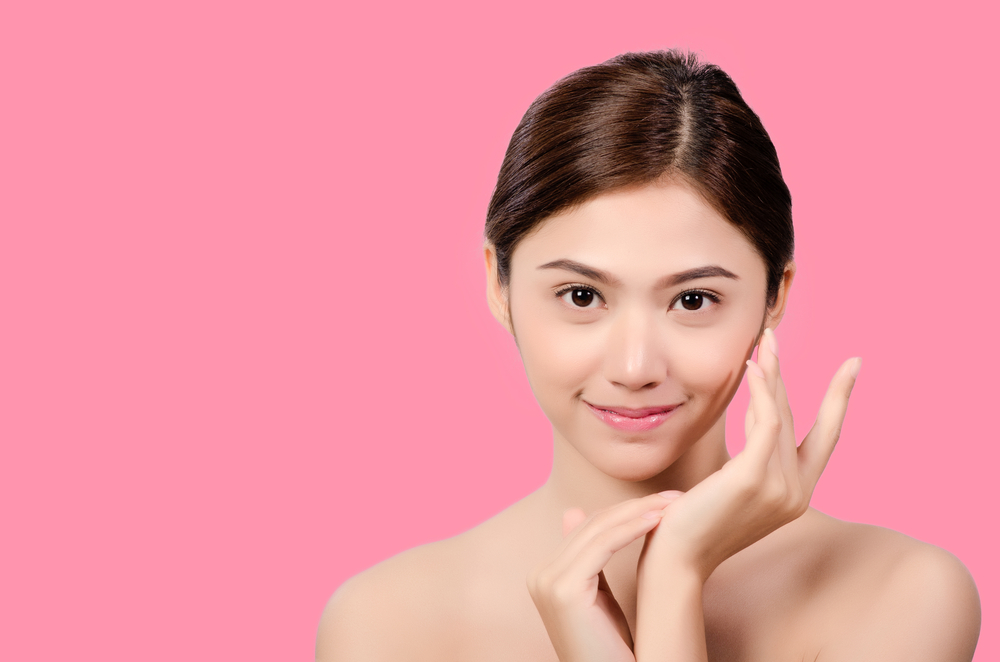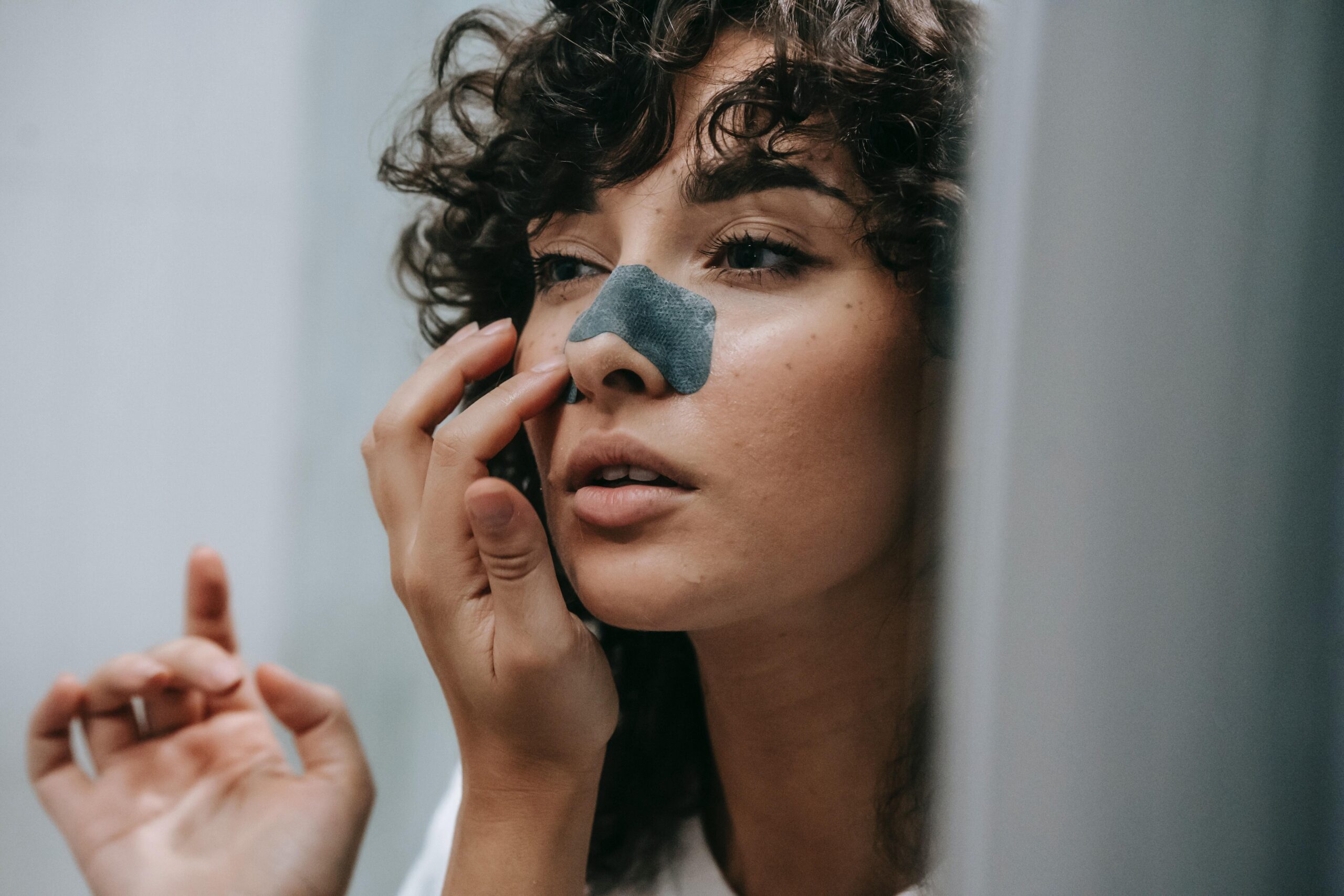Prepping for your new bundle of joy comes with a laundry list of no-nos: seafood, deli meat, caffeine and, of course, alcohol. As you clean out the fridge and pantry for nine months of safe eating, you’re also going to want to do some digging into your medicine cabinet and makeup bag.
There’s a slew of skin care products that are off-limits to pregnant women, and many that are perfectly safe, so it’s important to take a good look at your skincare routine to make sure it’s A-OK for your growing little one.
Here’s the inside-scoop on safe skincare while you’re expecting.
Common Pregnancy Skin Care Concerns
The pregnancy glow: if only you could bottle it and save it for later! On the downside, with pregnancy also comes a host of new skin concerns. Stretch marks are by far the most common — nine out of 10 women get them while pregnant — but other, lesser-known conditions are likely to occur as well.
Pruritic urticarial papules and plaques of pregnancy (PUPPP) is actually one of the most common skincare conditions that plagues women during pregnancy. PUPPP causes an itchy, bumpy rash that starts in the abdomen near stretch marks and spreads to other extremities relatively quickly.
You may also experience a darkening of the skin, hyperpigmentation, and unexpected breakouts while you’re pregnant. Even women who don’t usually have acne-prone or particularly sensitive skin may suddenly experience new rashes and sensitivities while pregnant.
Besides pregnancy-specific skin concerns, most women also want to maintain healthy, happy skin during those nine months of pregnancy. If you suffer common skin issues like acne, dry skin or redness, then you’ll want to take a look at the skincare ingredients on your favorite products to ensure they’re safe for your baby.
Topical Skin Care: What’s Safe and What’s Not
Just like the foods you eat, topical skin care products — including everything from sunscreen to body wash to tinted moisturizers — can absorb into your bloodstream. That means that what you put on your skin could adversely affect your child.
During pregnancy you’ll want to move towards organic products free of artificial dyes, formaldehyde, parabens and the harmful active ingredients listed below. Women with serious skin conditions will want to talk to a dermatologist before making any drastic changes to their skin care regimen or before using any new products.
Hydroxy Acids
If you have acne and rely on hydroxy acids, including alpha hydroxy acid (AHA) — which is an ingredient in aspirin — as well as beta hydroxy acids, don’t fret. Many women use AHAs like salicylic acid, glycolic acid, lactic acid and benzoyl peroxide to clear up blemishes during pregnancy.
Although there have been few studies on the topic, it’s widely known that only a small amount of the ingredients in these topical treatments absorb into the bloodstream, which makes them low-risk for pregnant women. With that being said, any prescriptions with high doses of these additives should be crossed off the list.
Additionally, any oral forms of these medications will introduce a greater concentration into the bloodstream, so they should be avoided during pregnancy.
Moisturizers
If you’re searching for a safe option to prevent stretch marks while pregnant, you’ll want to consider whether or not some of the more popular skin moisturizers are safe or not.
Pregnant women and new moms can safely use all-natural moisturizers, such as shea butter or cocoa butter made with coconut oil, to stave off those frustrating stretch marks.
Sunscreen
Proper sun protection is not only safe during pregnancy, it’s vital. Using a good-quality 35+ SPF sunscreen and wearing UPF clothing will help protect your extra-sensitive skin while you’re expecting.
Regular sunscreen ingredients like titanium dioxide and zinc oxide are considered safe for use by pregnant women.
Skin Care Ingredients to Avoid While Pregnant
If you still have questions regarding pregnancy-safe skin care ingredients, you should get familiar with the U.S. Food and Drug Administration (FDA) pregnancy drug classification system.
Drugs are rated either A, B, C, D or X, based on how safe they are for use by pregnant women. Classifications A and B are considered safe to use during pregnancy, while C and D should be avoided.
Any medication with an X classification by the FDA can represents a high risk of permanent damage to the fetus, and should never be used by anyone who is pregnant. Some X classification drugs should even be avoided by women concerned they may become pregnant in order to prevent reproductive complications.
Retinoids
If you’re taking preventative measures against acne and wrinkles, good for you. But topical retinoids like Retinol and Tretinoin should be off-limits during the nine months you’re expecting, and some have been shown to cause birth defects.
Although these blemish- and wrinkle-fighting additives are simply concentrated forms of vitamin A, doctors caution against using them during pregnancy. Tazorac, Accutane and Isotretinoin are all prescription vitamin A treatments that should not be used while pregnant. Accutane and Tazorac both carry an X classification by the FDA.
Thalidomide
You don’t just want to avoid thalidomide if you’re pregnant, you want to make sure you’re never exposed to it. This drug was widely prescribed in the 1950s and ‘60s to treat nausea in pregnancy, but led to devastating birth defects, in particular extremely malformed limbs. As a result, it’s used less and less today, but may still be prescribed for treating skin conditions associated with leprosy. Obviously, thalidomide carries an X rating by the FDA.
Hydroquinone
The topical depigmenting agent hydroquinone is regularly used to treat skin issues like chloasma and melasma, and is sometimes used cosmetically to achieve a lighter skin tone.
You shouldn’t use hydroquinone while pregnant as it is classified as a category C drug. This is because it has a higher absorption rate than other topical treatments, so it’s more likely that higher amounts could enter your bloodstream and affect the growth of your baby.
Formaldehyde
For a long time the preserving agent formaldehyde was commonly used in skincare and beauty products, but because it’s now classified as a known carcinogen and can cause cancer, some states are outlawing its use in certain products.
Luckily, more and more skincare companies have come out with product lines that are totally formaldehyde-free. Make sure you look at all of your skin and beauty products before use to ensure that do not contain formaldehyde.
Skin Rejuvenation Treatments
Now that we’ve covered common topical skincare ingredients, let’s delve into the safety of certain skin rejuvenation treatments. Unfortunately, there’s very little evidence available on which treatments are safe for pregnant women, meaning that most, if not all, in-office skin treatments should be avoided during pregnancy.
Doctors caution against the vast majority of these types of treatments for pregnant women, since their effects are not widely known.
Botox and Fillers
Skin-smoothers like Botox are borderline miracle-workers, but they may not be safe for use by pregnant women. Unfortunately, there have been no conclusive studies on the matter, so for now, doctors recommend avoiding Botox while pregnant. The same goes for popular filler injections like Voluma and Vollure.
Laser Treatments
There are seemingly infinite reasons to get laser treatments, from zapping away unwanted hair growth to correcting deep wrinkles and fine lines.
There’s some debate and controversy about whether having laser procedures done during pregnancy is safe. Some specialists say that the lasers don’t penetrate the skin, and therefore pose no risk to pregnant women, while others recommend avoiding it altogether.
Microneedling
A microneedling session could be just what you need to give yourself a feel-good boost while pregnant, but you should think twice before going under the needle. This procedure can be used to help increase collagen production and plump up the skin, but due to the absence of clinical research on the topic, it should not be used by pregnant women.
Chemical Peels
Microdermabrasion and chemical peel treatments can be used to safely remove the outer layer of the skin to create a fresh, new look. These treatments can seriously restore your skin, but the fact of the matter is they’re almost entirely chemicals, which can absorb into the bloodstream. It’s best to avoid chemical peels while pregnant, especially in their particularly potent forms.
Just like anything else you put in your body, skincare products can affect the health of your unborn baby. It’s always a good idea to talk to your dermatologist and obstetrician about your particular skin issues so that they can create a regimen that’s safe for both you and your little one.
8 Common Skin Conditions During Pregnancy
It’s not all about the glow. Hormone and weight fluctuations during pregnancy can lead to a host of skin problems.
Acne
These annoying breakouts are tied to our hormones. During pregnancy, women’s bodies produce more androgen, the male sex hormone, and progesterone, which in turn cause oil glands in the skin to produce more oil (sebum). This can clog the oil glands and lead to inflammation and increased bacteria on the skin, thus encouraging the development of blackheads.
Women with existing acne problems or who’ve struggled with acne in the past are more susceptible to breakouts during pregnancy, although any woman can experience pregnancy-related breakouts. Thankfully, the skin typically goes back to normal after pregnancy.
Pruritic Urticarial Papules and Plaques of Pregnancy (PUPPP)
Pruritic Urticarial Papules and Plaques of Pregnancy (PUPPP), also called polymorphic eruption of pregnancy, may look a little like acne, but these small red bumps are not zits.
The condition usually starts as a series of red bumps on the abdomen near where stretch marks may be forming. From there, it can spread to the arms, legs, and buttocks. The spots range in size from small points (papules) to large round hive-like welts (plaques) and are extremely uncomfortable, causing moderate to severe itching and/or burning.
Experts theorize the condition is an immune response brought on by the stretching of the belly’s skin and as such is often treated with prescription antihistamines to help relieve symptoms. Women can also take lukewarm baths and wear light and loose clothing to reduce itching. The condition typically resolves itself within the first month or two post-childbirth.
Melasma
Also known as chloasma, this form of hyperpigmentation is so common during pregnancy that it’s often referred to as “the mask of pregnancy.”
Hyperpigmentation, when the skin becomes darker in certain spots, typically results from an overproduction of melanin (pigment), the amount of which dictates the color of your skin. When it comes to pregnancy, this overproduction is often triggered by increased estrogen and progesterone levels.
The placenta is also linked with an increase in melanin. It encourages the production of melanocyte-stimulating hormones (MSH), which lead to more melanocytes, the cells that produce melanin.
Melasma refers to tan or brown patches (hyperpigmentation) in the face, particularly the upper cheeks, forehead, and upper lip. The condition is harmless, painless, and usually disappears in the first few months following pregnancy. Women can reduce the appearance of melasma by wearing sunscreen and avoiding direct sunlight during peak hours.
Linea Nigra
This form of hyperpigmentation is alarming to witness but ultimately harmless. The linea nigra, Latin for “black line,” is a line of darkened skin that travels vertically across the center of the belly. It’s more noticeable on some people than others.
The linea nigra is caused by the same factors that lead to melasma. However, it’s possible to develop one even when you don’t have melasma. This incredibly common skin condition is present in about three quarters of pregnancies.
The linea nigra will also disappear after pregnancy, although it sometimes takes several weeks.
Spider Angiomas
Sometimes referred to as spider nevus or spider veins, this condition resembles a red spider with legs reaching in every direction. In reality, spider angiomas are groups of dilated blood vessels that all branch out from a central point.
Although the exact cause is unknown, spider angiomas are thought to result from hormonal changes, especially where pregnancy is concerned. They appear on the face, chest, abdomen, and arms, and typically resolve themselves after pregnancy. However, if your spider angiomas don’t go away, you can always consider removing them with laser therapy.
Skin Tags
Skin tags can happen at any time, but they are somewhat more common during pregnancy. These small flaps of loose skin are benign and painless — unless you mess with them. Skin tags tend to develop on the neck, chest, back, armpits, even under the breasts.
Skin tags are possibly the result of increased blood flow to the skin’s surface, encouraging excess tissue to grow. Estrogen is also thought to influence their development, and with pregnancy comes of estrogen.
Never attempt to remove skin tags on your own. Your physician can remove them very easily with a scalpel or scissors. In some cases, your surgeon may even burn them off via electrosurgery.
Eczema
Atopic dermatitis (eczema) is characterized by itchy patches of dry skin that look like hives or rashes. It comes and goes, varying widely in severity.
As with acne, pregnant women with a history of eczema will find that their skin condition worsens with pregnancy. However, some pregnant women might develop the condition for the first time during pregnancy. When this happens, it’s referred to as atopic eruption of pregnancy (AEP).
Eczema can’t be cured, but it can be managed. Moisturizers do the trick for mild cases, and when eczema is more severe physicians simply prescribe topical corticosteroids to address the condition.
Stretch Marks
This is probably the most well-known skin condition associated with pregnancy. The belly’s skin stretches as it grows, causing the skin to scar. Stretch marks can also show up on the thighs and breasts when there has been rapid weight gain.
These marks start out looking red or purple, but don’t be alarmed, they fade to white over time, becoming much less visible.
There are a lot of over-the-counter creams on the market that promise to prevent or remove stretch marks. The efficacy of these drugs, however, is somewhat questionable. Many medical professionals agree that there’s no way to prevent stretch marks and there may even be a genetic component dictating who is more likely to get them.
Pregnancy is a delicate time in a woman’s life. Consult with your physician before attempting any new skincare regime or products, and finally, remember to be patient. Some of these issues will simply disappear as your hormones get back to normal.
» If you are experiencing skin changes during or after pregnancy, get suggestions from our medical review team. They help you learn more about how you can safely address them.









